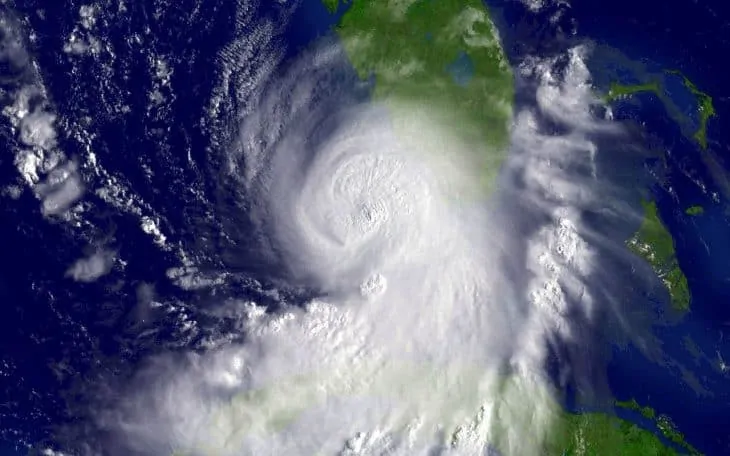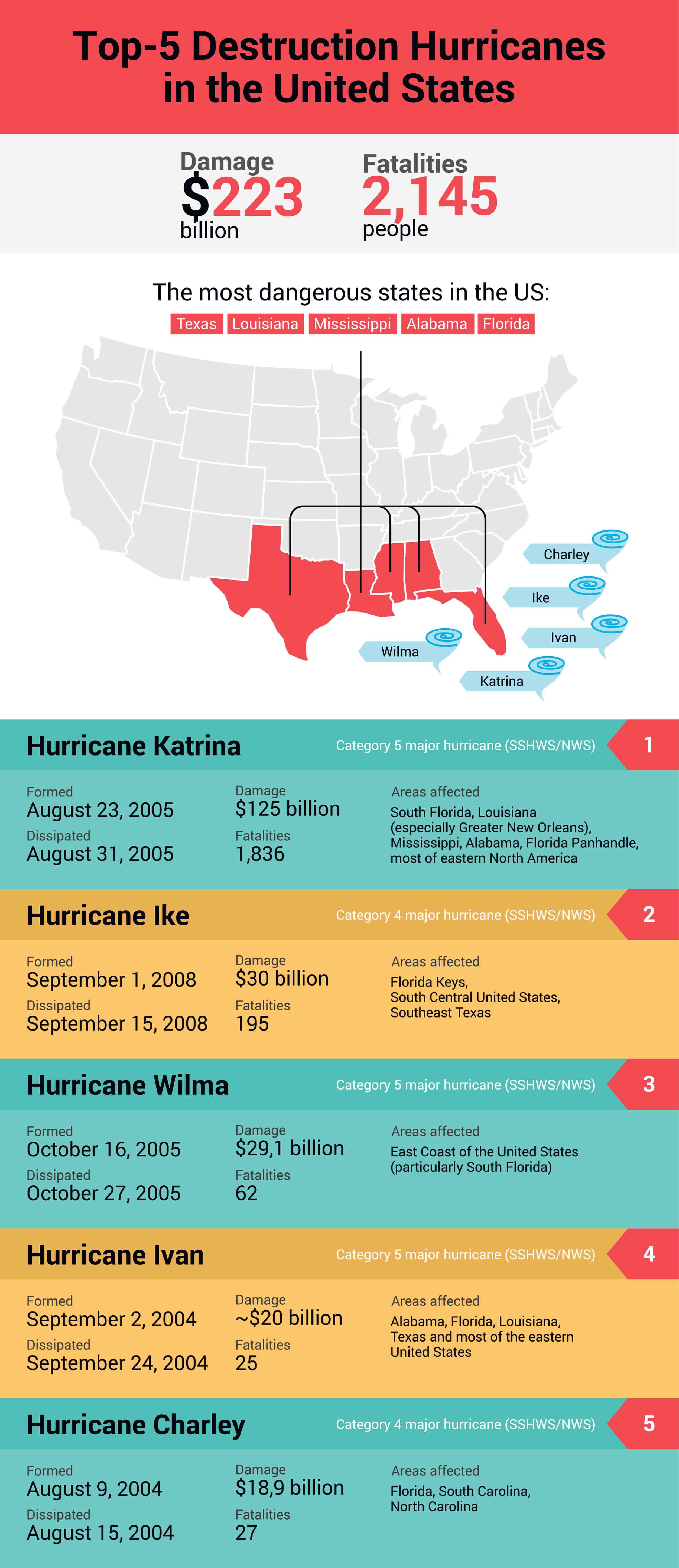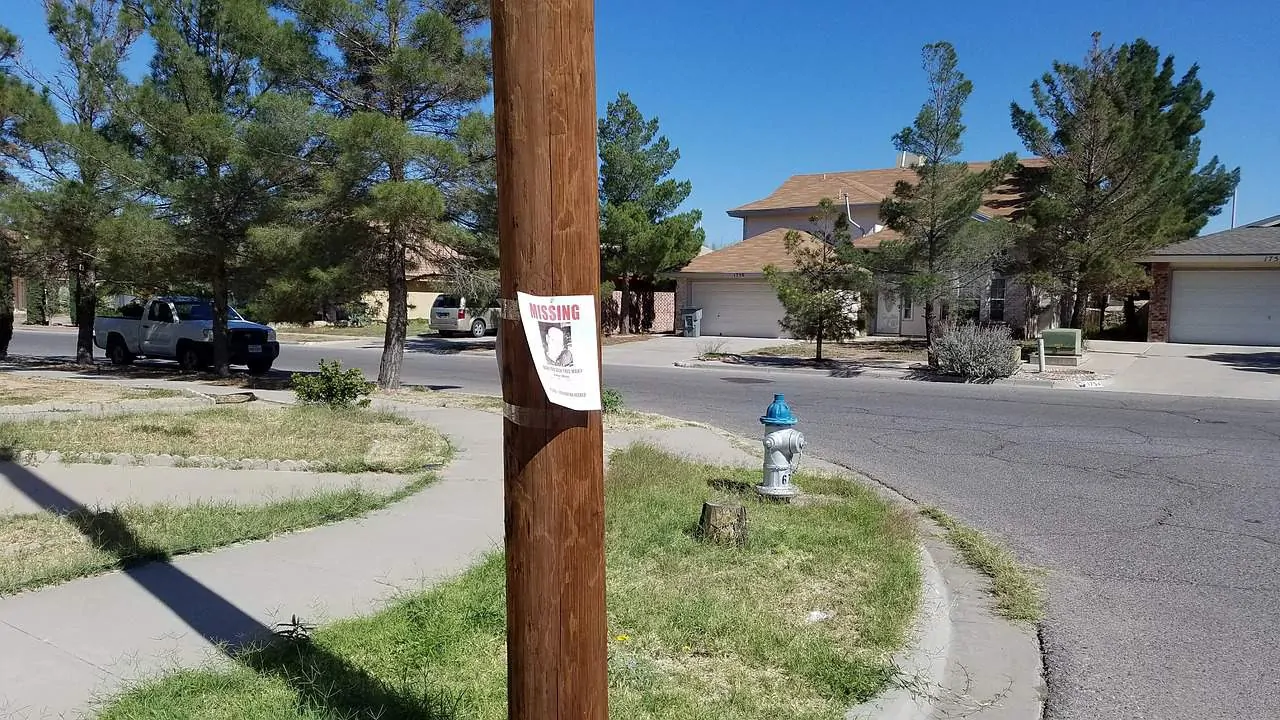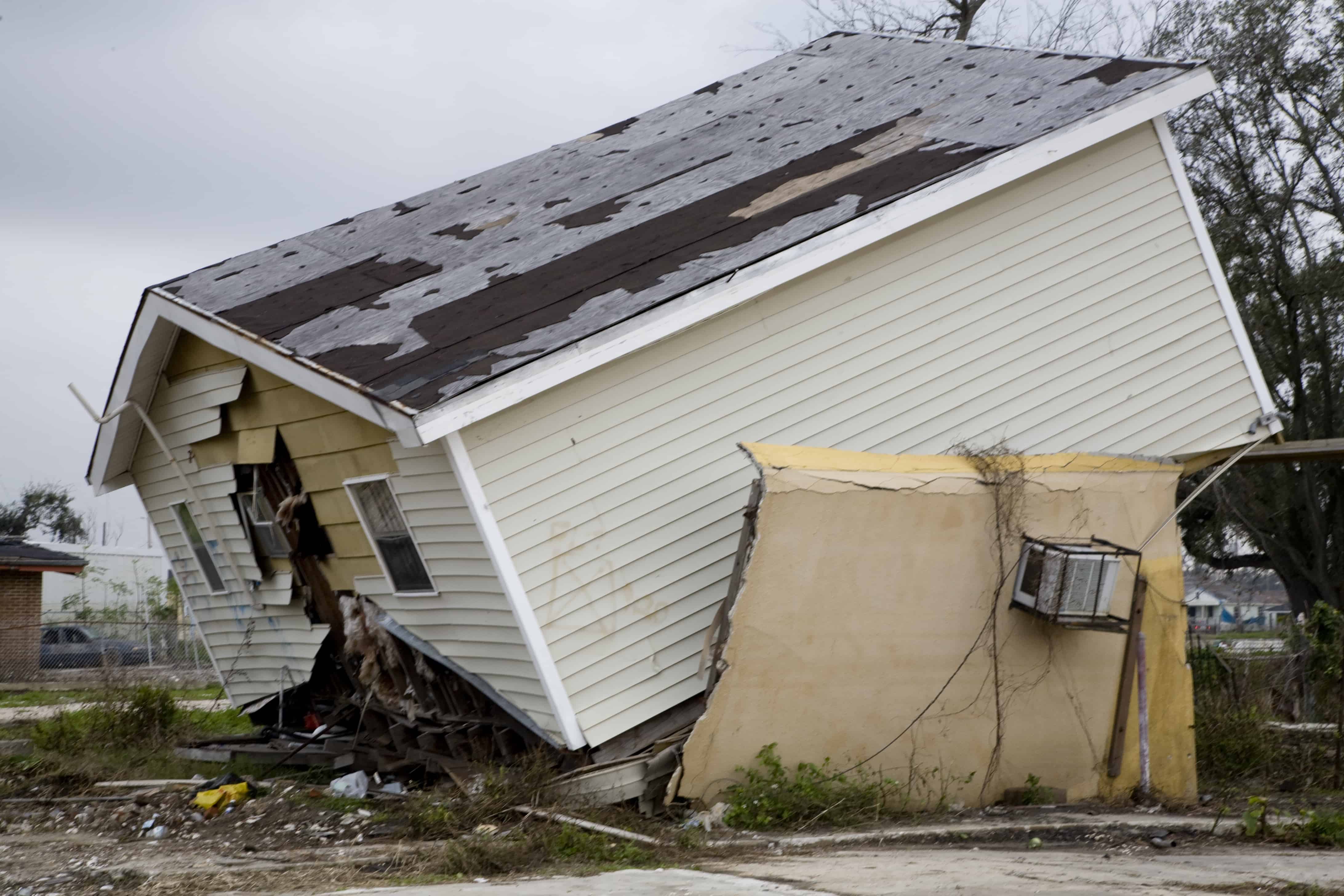
Hurricane Katrina was one of the most destructive and deadliest hurricanes ever that hit the United States. It affected many states along its course, with New Orleans suffering the worst hit. The hurricane destroyed the protective system of New Orleans had in place for many years, and also caused residents to lose their homes and loved ones in this disaster. Let’s learn more about this catastrophe with these Hurricane Katrina facts.
- Hurricane Katrina was a Category 5 Atlantic hurricane.
- The highest wind speed achieved was 280 kilometers per hour.
- Hurricane Katrina started to form on August 23, 2005.
- It dissipated on August 31, 2005.
- Hurricane Katrina was one of the most deadly hurricanes with over 1,800 fatalities.
- The United States received the hardest hit from Hurricane Katrina.
- Hurricane Katrina was a tropical cyclone that brought extremely strong winds and a spiral arrangement of thunderstorms with heavy rain.
- On August 25, 2005, the storm reached hurricane status and caused landfall in Florida as a Category 1 storm.
- Tens of thousands of individuals who got directly affected only had a little food and necessities.
- On August 26, 2005, Hurricane Katrina became a Category 2 hurricane. Soon, it moved northwest through the waters of the Gulf of Mexico.
- By August 28, 2005, Hurricane Katrina was upgraded from a Category 3 to a Category 5 hurricane.
- It was on August 28 and 29 when Hurricane Katrina dealt the biggest damages in the U.S. States that were affected.
- The downgrading of Hurricane Katrina from a Category 5 hurricane down to tropical depression occurred on Aug 30, 2005.
- Hurricane Katrina was one of the largest hurricanes that the United States ever had.
- U.S. President George W. Bush announced a state of emergency in several regions of Alabama, Louisiana, and Mississippi due to Hurricane Katrina.
- Hurricane Katrina was amongst the strongest tropical cyclones that formed on earth.
- The storm surge from the hurricane was around 10 to 20 feet high.
- More than 700 people were still missing after the incident.
- Katrina’s death toll was technically uncertain and its estimates differing by hundreds.
- Mississippi’s forestry industry was widely affected, as 5,300 square kilometers of forest lands were ruined.
Hurricane Katrina was about 2.4 times stronger than a usual hurricane.
A Category 1 hurricane produces strong winds between 119 to 152 kph. A Category 2 hurricane brings dangerous winds of 153 to 177 kph. Furthermore, a Category 3 hurricane carries winds around 177 to 207 kph which gives a high risk of death and injury within its area. Category 4 is from 208 to 251 kph. Meanwhile, a Category 5 hurricane such as Hurricane Katrina has a wind strength of more than 252 kph.
New Orleans and Mississippi were among the hardest hit in the U.S.
In the United States, the most affected places were New Orleans, Louisiana, Mississippi, Alabama, New Jersey, Georgia, Pennsylvania, Ohio, New York, Florida, Kentucky, and West Virginia. Moreover, there were also some major damages in other countries including Canada, Cuba, and the Bahamas.
New Orleans had a huge flood.

In August 2005, approximately more than 75% of New Orleans was flooded. Some places were submerged under 20 ft of water. Higher places such as Garden District and French Quarter dodged the flooding because they are above sea level.
Many people were stranded in New Orleans.
Hurricane Katrina might have dissipated on August 31, 2005. But due to massive damages, the stranded people in New Orleans were still helpless as of September 2, 2005. They had no services or assistance. Eventually, the National Guard personal arrived to establish order and brought aid.
Hurricane Katrina was the costliest hurricane ever in U.S. history.
The total damages of Hurricane Katrina in 2005 cost around $160 billion. $125 billion of that was property damage. Thus, Hurricane Katrina earned the title of the costliest hurricane ever in the United States’ history.

Fourteen hurricanes formed in the 2005 Atlantic hurricane season.
Katrina was the 3rd major hurricane of the 2005 Atlantic hurricane season, the 5th hurricane in that year, as well as the 12th tropical cyclone. Moreover, it was the 4th most intense Atlantic hurricane on record to make landfall in the contiguous United States.
More than 70 countries around the world helped the United States.
Many countries around the world helped the United States, including Afganistan who donated $100,000 to the US government. Australia donated $7.6 million. Belgium provided operations teams, generators, water pumps, etc. China donated $5.1 million. Singapore provided helicopters. Spain gave relief supplies. Taiwan sent $2 million and relief supplies. Oman donated $15 million, and Korea with $30 million.
World Vision helped areas with low insurance coverage.
The World Vision also helped the United States by providing emergency supplies to the most affected regions. Back then, World Vision’s strategic plan was to focus on helping the areas where insurance coverage is low and poverty rates are high such as Mississippi and Louisiana.
World Vision helped more than 300,000 people.
In total, World Vision provided $500,000 which they divided to 500 evacuated families ($1,000 each), distributed $6.2 million to the churches, helped more than 60,000 students by giving school supplies, as well as giving out $15.6 million worth of relief supplies, personal hygiene items, clothes, bedding, toys, and cash to the needy.
The United States tried to fix the problems from Hurricane Katrina single-handedly.
At first, the United States government had been hesitant to accept assistance, aids, and donations from foreign countries. However, this decision changed when the reports of damages intensified. In the end, the United States accepted foreign aid accordingly.
Scammers took advantage of the disaster.
To most fraudsters and scammers, a major calamity such as Hurricane Katrina was an opportunity for them. In light of the support coming from all over the world, numerous scam artists seized the opportunity of the crowd’s enthusiasm to donate money and resources to victims of Hurricane Katrina. Furthermore, according to the Federal Bureau of Investigation (FBI), there were more than 500 illegal websites that collected money which did not benefit the victims by baiting them using email spam.
One week after Hurricane Katrina had left, thousands were still missing.

Some organizations and companies such as The Weather Channel, Craigslist, and Red Cross put up a website that provided important information for the affected families. Moreover, the giant web services provider, Yahoo placed around 100 Internet-linked computers at the evacuation areas and created a meta-search for the evacuee’s registration websites. These efforts had helped many people although it was already 1 week after Hurricane Katrina had happened, yet thousands remained missing.
The unstable internet connection was also challenging.
According to some, numerous survivors had no internet connection and no electrical power. On the other hand, for those who had access, survivors encountered too many websites, where some were not user-friendly, along with fraud or fake websites, making it more challenging to track these missing persons.
The storm surge is often the deadliest part of the hurricane.
When Hurricane Katrina’s robust right-front quadrant (the right-front quadrant of any hurricane normally brings stronger winds and storm surge) crossed over the west and central Mississippi coast, it developed a strong storm surge (about 25 to 30 feet in height). It trampled to over 15 kilometers in the area that led to catastrophic damages.
Controversies piled up after the disaster.
Some of the controversies that arose immediately were whether the federal US Army Corps of Engineers used substandard materials for it should have held back the storm surge otherwise. And if it was not, whether if the US Army Corps of Engineers should overhaul their construction policies, engineering, and design.
Hurricane Katrina also brought the country's long term issues to light.
Hurricane Katrina brought long term issues of the United States to light. One was whether they needed to revamp the policies that affect the poor including bankruptcy legislation. This was to make it more convenient for the lower class and help them recover much faster in case of another disaster.
Many believe that global warming had something to do with Hurricane Katrina.
Many analysts, observers, and commentators felt that global warming had something to do with it. Most of them argued that global warming seriously raises the odds of hostile weather events, and even for the future.
The hurricane had an overwhelming effect on the survivors, especially children.
Many people have suffered in this calamity, some lost their loved ones, some lost their homes, some lost their livelihood, and many more. But the most devastating was the mental effect on children after the event. Moreover, they were the ones who are vulnerable to suffering from lost loved ones, possessions, and even pets. It was a huge adjustment to them as most families had to evacuate their place and settled in a new environment.

Coordination and preparedness were some of the biggest lessons to learn from Hurricane Katrina.
Hurricane Katrina taught the United States a lot of lessons such as coordination and preparedness. The lack of coordination between government, organizations, pharmaceutical companies, and non-profit relief groups created unwanted barriers. For instance, medical deliveries that were held up at checkpoints resulted in countless phone calls between individuals and government officials (with almost the same questions repeated again and again) instead of better utilizing the time for more important matters.
"Katrina was not an equal opportunity storm."
More than 15 years now, some parts of New Orleans are still recovering from the damages of Hurricane Katrina. Moreover, according to some, “Katrina was not an equal opportunity storm” where a black homeowner in New Orleans would be more likely to have his or her house flooded, compared to a white homeowner. Some of them argued that it wasn’t just “bad luck” but due to racial discriminatory housing practices.
Was this page helpful?
Our commitment to delivering trustworthy and engaging content is at the heart of what we do. Each fact on our site is contributed by real users like you, bringing a wealth of diverse insights and information. To ensure the highest standards of accuracy and reliability, our dedicated editors meticulously review each submission. This process guarantees that the facts we share are not only fascinating but also credible. Trust in our commitment to quality and authenticity as you explore and learn with us.
